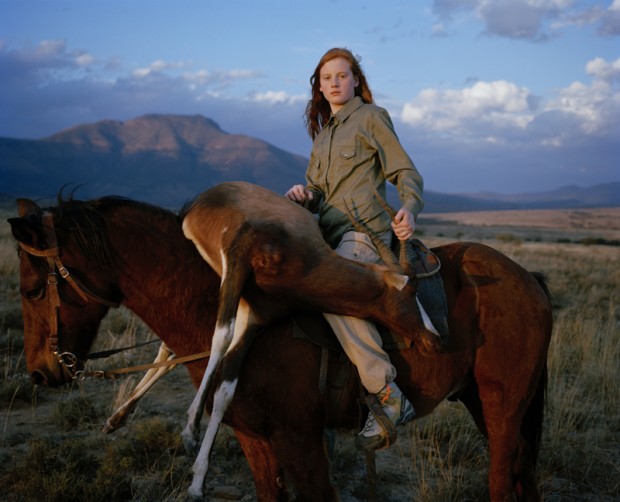An iconographic and text archive related to communication, technology and art.
☛ David Chancellor: “Huntress with buck, south africa” from the Hunters ongoing series.
The young red hair woman in the picture is 14 years old. You may like or dislike the photograph, it remains quite a striking portrait. The small girl mounted on a horse proudly but calmly poses beside a massive dead buck. While she holds the animal’s horns with one assured hand, one can clearly see the wound that killed it (and imagine the violence of the impact made by the bullet). And yet, everything seems peaceful, even the horse. One could say the sunset of a big game is the dawn of a delicate huntress.
Artist statement:
This series of portraits is part of an ongoing project documenting the game hunting industry in Sub Saharan Africa. During the early 20th century, the tourist trophy hunting industry started in Kenya, wealthy European and American visitors paid settler farmers to guide them on hunting safaris in the area. Similar tourist hunting industries soon developed elsewhere in Africa. During the 1980s and 1990s, the potential for tourist hunting to create financial incentives for conservation was increasingly recognized and in several nations there was a gradual alignment of trophy hunting with conservation and development programmes. Well known examples of this include the Communal Areas Management Programme for Indigenous Resources (CAMPFIRE) programme in Zimbabwe (Elephant Story). Trophy hunting is now a major industry in Africa occurring in 23 sub Saharan African countries, and generates in excess of USD 201 million/year from +/- 18500 international hunting clients. Approximately 1.4 million km2 is used for trophy hunting, which is an area 22% larger than, and in addition to the area encompassed by all the national parks (ie. Protected areas where hunting is not permitted). South Africa has the largest hunting industry. There are also well developed hunting industries in Zimbabwe, Botswana and Namibia, and to a lesser extent Zambia, Mozambique and Swaziland. The southern African hunting industry has grown during recent years due partly to a major increase in game ranching in place of traditional livestock farming. Hunters and hunting advocates insist that trophy hunting is of major importance for conservation in Africa. However, animal rights groups fundamentally oppose hunting and there is a lack of consensus among conservationists regarding the acceptability and efficacy of hunting as a conservation tool…
The portrait depicted above won the Taylor Wessing Photographic Portrait Prize 2010.
About David Chancellor:
Named Nikon photographer of the year three times, he received a World Press Photo in 2010 for ‘Elephant Story’ from the series ‘Hunters’. A study of his wife and son was exhibited at the National Portrait Gallery London (2009) and the following year he won the Taylor Wessing Portrait Prize, at the National Portrait Gallery, with ‘Huntress with Buck’ from the series ‘Hunters’. In 2011 he was shortlisted for the Sony World Photography Organization Award. His first monograph ‘Hunters’ will be published in 2011. (Profile)
Below are more online resources about David Chancellor:
- David Chancellor is represented by Institute.
- The Daily Mail: “The deer hunter: Picture of girl, 14, on first shooting trip with dead prize slung across horse wins top award in photo contest”, November 11, 2010:
‘Josie had hunted her buck earlier in the day and was returning to camp… The contrast between the peace and tranquility of the location, plus Josie’s ethereal beauty and the dead buck, was what I wanted to explore.”
- The Guardian: “Taylor Wessing portrait prize goes to photograph of teenage hunter” by Mark Brown, November 10, 2010:
The image shows 14-year-old Josie Slaughter from Alabama on her first hunting trip to South Africa. Against a stunning background and sky, she looks impassively in to the camera, holding the dead animal’s antlers up to prevent it flopping lifelessly over the horse’s neck. […] He said he wanted “to explore the intricate and complex relationship between man and animals and how both struggle to adapt to their changing environment.”
- Artdaily.org: “Winner of the Taylor Wessing Photographic Prize Announced at the National Portrait Gallery”, November 10, 2010:
Chancellor spent two days with the 14 year old and her family, shooting Kodak 160VC 120 film on a Mamiya 7 II camera. The painterly quality of light is a striking component of Chancellor’s winning entry. ‘I’ve always been interested in Africa; it’s impossible not to be inspired by the place,’ he says. ‘Once you are bitten by the continent you never recover. And for an artist or photographer, the light is indescribable.’ While Chancellor acknowledges that hunting is an emotive subject, he stresses the importance of remaining objective in his reportage. ‘The aim is always to be detached’, he says. ‘In reality that’s rarely possible, but I do hope I can observe without an agenda and without the necessity to shout.’

